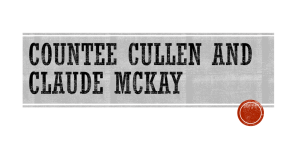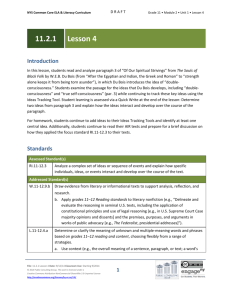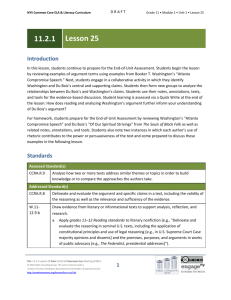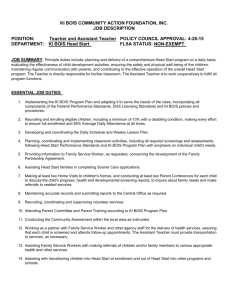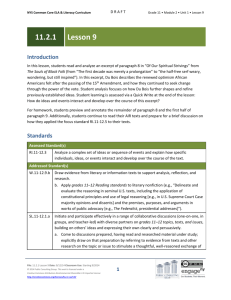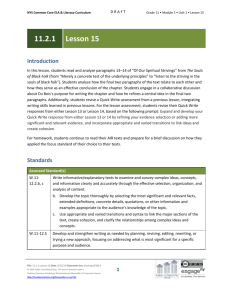Grade 11 ELA Module 2, Unit 1, Lesson 14
advertisement
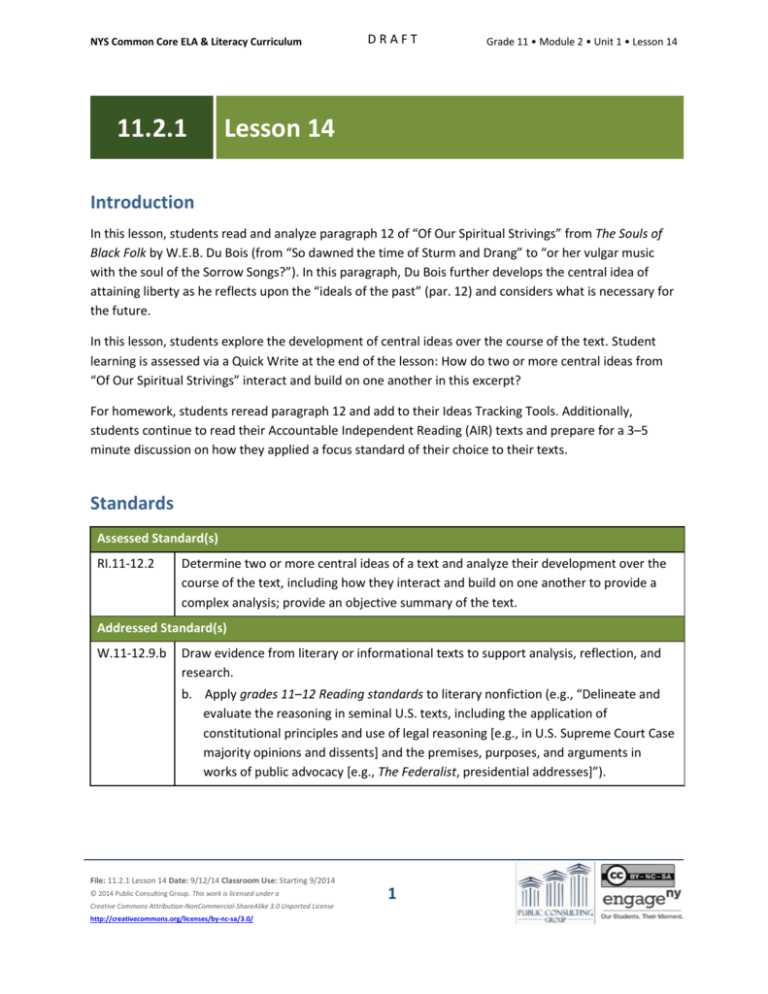
NYS Common Core ELA & Literacy Curriculum 11.2.1 DRAFT Grade 11 • Module 2 • Unit 1 • Lesson 14 Lesson 14 Introduction In this lesson, students read and analyze paragraph 12 of “Of Our Spiritual Strivings” from The Souls of Black Folk by W.E.B. Du Bois (from “So dawned the time of Sturm and Drang” to “or her vulgar music with the soul of the Sorrow Songs?”). In this paragraph, Du Bois further develops the central idea of attaining liberty as he reflects upon the “ideals of the past” (par. 12) and considers what is necessary for the future. In this lesson, students explore the development of central ideas over the course of the text. Student learning is assessed via a Quick Write at the end of the lesson: How do two or more central ideas from “Of Our Spiritual Strivings” interact and build on one another in this excerpt? For homework, students reread paragraph 12 and add to their Ideas Tracking Tools. Additionally, students continue to read their Accountable Independent Reading (AIR) texts and prepare for a 3–5 minute discussion on how they applied a focus standard of their choice to their texts. Standards Assessed Standard(s) RI.11-12.2 Determine two or more central ideas of a text and analyze their development over the course of the text, including how they interact and build on one another to provide a complex analysis; provide an objective summary of the text. Addressed Standard(s) W.11-12.9.b Draw evidence from literary or informational texts to support analysis, reflection, and research. b. Apply grades 11–12 Reading standards to literary nonfiction (e.g., “Delineate and evaluate the reasoning in seminal U.S. texts, including the application of constitutional principles and use of legal reasoning [e.g., in U.S. Supreme Court Case majority opinions and dissents] and the premises, purposes, and arguments in works of public advocacy [e.g., The Federalist, presidential addresses]”). File: 11.2.1 Lesson 14 Date: 9/12/14 Classroom Use: Starting 9/2014 © 2014 Public Consulting Group. This work is licensed under a Creative Commons Attribution-NonCommercial-ShareAlike 3.0 Unported License http://creativecommons.org/licenses/by-nc-sa/3.0/ 1 NYS Common Core ELA & Literacy Curriculum DRAFT Grade 11 • Module 2 • Unit 1 • Lesson 14 Assessment Assessment(s) Student learning is assessed via a Quick Write at the end of the lesson. Students respond to the following prompt, citing textual evidence to support analysis and inferences drawn from the text. How do two or more central ideas from “Of Our Spiritual Strivings” interact and build on one another in this excerpt? High Performance Response(s) A High Performance Response should: Identify two or more central ideas in this excerpt (e.g., self-consciousness and liberty). Analyze how two or more central ideas interact or build on one another in this excerpt (e.g., Du Bois develops the central idea of liberty by describing complete liberty as “the ideal of human brotherhood” which is gained through “the unifying ideal of Race” (par. 12). Du Bois suggests “human brotherhood” (par. 12), or complete liberty, is only achieved when both races can exchange characteristics equally. This can only happen when African Americans respect and value themselves” (par. 12). This idea that “[H]uman brotherhood” (par. 12), or complete liberty, begins with self-respect and self-knowledge of African Americans is an expression of Du Bois’s idea of selfconsciousness. Du Bois expands the idea of self-consciousness in this excerpt by describing the end result of self-consciousness as a unified America.). Vocabulary Vocabulary to provide directly (will not include extended instruction) Sturm und Drang (n.) – storm and stress Sturm und Drang is from the German language. rending (v.) – pulling or tearing violently waxed and waned (idiom.) – increased and decreased, as size, number, strength, or intensity credulous (adj.) – willing to believe or trust too readily, especially without proper or adequate evidence deft (adj.) – skillful and clever successively (adv.) – consecutively; one at a time exponents (n.) – people or things that are representatives, advocates, types, or symbols of something File: 11.2.1 Lesson 14 Date: 9/12/14 Classroom Use: Starting 9/2014 © 2014 Public Consulting Group. This work is licensed under a Creative Commons Attribution-NonCommercial-ShareAlike 3.0 Unported License http://creativecommons.org/licenses/by-nc-sa/3.0/ 2 NYS Common Core ELA & Literacy Curriculum DRAFT Grade 11 • Module 2 • Unit 1 • Lesson 14 reverence (n.) – a feeling or attitude of deep respect tinged with awe dyspeptic (adj.) – gloomy, pessimistic, and irritable blundering (adj.) – moving or acting blindly, stupidly, or without direction or steady guidance jovial (adj.) – characterized by a hearty, joyous humor or a spirit of good-fellowship vulgar (adj.) – current, popular, common Vocabulary to teach (may include direct word work and/or questions) None. Additional vocabulary to support English Language Learners (to provide directly) limb (n.) – a leg or arm fostering (v.) – helping (something) grow or develop conformity (n.) – the fact or state of agreeing with or obeying something sole (adj.) – only or single oasis (n.) – a pleasant place that is surrounded by something unpleasant humility (n.) – the quality or state of not thinking you are better than other people coarse (adj.) – rude or offensive Lesson Agenda/Overview Student-Facing Agenda % of Lesson Standards & Text: Standards: RI.11-12.2, W.11-12.9.b Text: The Souls of Black Folk by W.E.B. Du Bois, Chapter 1: “Of Our Spiritual Strivings,” paragraph 12 Learning Sequence: 1. 2. 3. 4. 5. 6. Introduction of Lesson Agenda Homework Accountability Masterful Reading Reading and Discussion Quick Write Closing 1. 2. 3. 4. 5. 6. File: 11.2.1 Lesson 14 Date: 9/12/14 Classroom Use: Starting 9/2014 © 2014 Public Consulting Group. This work is licensed under a Creative Commons Attribution-NonCommercial-ShareAlike 3.0 Unported License http://creativecommons.org/licenses/by-nc-sa/3.0/ 3 5% 15% 5% 60% 10% 5% NYS Common Core ELA & Literacy Curriculum DRAFT Grade 11 • Module 2 • Unit 1 • Lesson 14 Materials Student copies of the Ideas Tracking Tool (refer to 11.2.1 Lesson 2)—students may need additional blank copies Student copies of the Short Response Rubric and Checklist (refer to 11.2.1 Lesson 1) Learning Sequence How to Use the Learning Sequence Symbol Type of Text & Interpretation of the Symbol 10% no symbol Percentage indicates the percentage of lesson time each activity should take. Plain text indicates teacher action. Bold text indicates questions for the teacher to ask students. Italicized text indicates a vocabulary word. Indicates student action(s). Indicates possible student response(s) to teacher questions. Indicates instructional notes for the teacher. Activity 1: Introduction of Lesson Agenda 5% Begin by reviewing the agenda and the assessed standard for this lesson: RI.11-12.2. In this lesson, students read paragraph 12 and analyze how Du Bois further develops the central idea of liberty in this excerpt. Students look at the agenda. Activity 2: Homework Accountability 15% Instruct students to take out their responses to the previous lesson’s homework assignment. (Preview and annotate paragraph 12, box unfamiliar words, and look up their definitions. Choose the definition that makes the most sense in context, and write a brief definition above or near the word in the text. Additionally, read and annotate an excerpt from the Declaration of Independence as preparation for the next lesson.) Instruct students to talk in pairs about their annotations for the previous lesson’s homework. Student responses may include: File: 11.2.1 Lesson 14 Date: 9/12/14 Classroom Use: Starting 9/2014 © 2014 Public Consulting Group. This work is licensed under a Creative Commons Attribution-NonCommercial-ShareAlike 3.0 Unported License http://creativecommons.org/licenses/by-nc-sa/3.0/ 4 NYS Common Core ELA & Literacy Curriculum o o o DRAFT Grade 11 • Module 2 • Unit 1 • Lesson 14 A star next to “our little boat on the mad waters of the world-sea” (par. 12) because Du Bois uses a metaphor at the beginning of the paragraph to create an image of African Americans during difficult times. A question mark next to “To be really true, all these ideals must be melted and welded into one” (par. 12). How does this idea change what the ideals mean? An exclamation point next to “else what shall save us from a second slavery?” (par. 12). This reference to “a second slavery” (par. 12) emphasizes how passionate Du Bois is about the power of voting rights. This annotation supports students’ engagement with W.11-12.9.b, which addresses the use of textual evidence in writing. Instruct students to share and discuss the vocabulary words they identified and defined in the previous lesson’s homework. Students may identify the following words: Sturm und Drang, rending, waxed and waned, credulous, deft, successively, exponents, reverence, dyspeptic, blundering, jovial, vulgar. Definitions are provided in the Vocabulary box in this lesson. Instruct students to talk in pairs about their annotations of the excerpt from the Declaration of Independence. Student responses may include: o o o An exclamation point next to “all men are created equal” because the Declaration of Independence guarantees equality for all men without exception. A star next to the rights of “Life, Liberty, and the pursuit of Happiness”; these rights guarantee equality for all Americans. A question mark next to the idea that governmental power comes from “the consent of the governed.” Does this refer to voting rights? Lead a brief whole-class discussion of student responses. Explain to students that they consider their annotation and discussion of the Declaration of Independence excerpt as they engage in the reading and discussion portion of this lesson. File: 11.2.1 Lesson 14 Date: 9/12/14 Classroom Use: Starting 9/2014 © 2014 Public Consulting Group. This work is licensed under a Creative Commons Attribution-NonCommercial-ShareAlike 3.0 Unported License http://creativecommons.org/licenses/by-nc-sa/3.0/ 5 NYS Common Core ELA & Literacy Curriculum DRAFT Grade 11 • Module 2 • Unit 1 • Lesson 14 Activity 3: Masterful Reading 5% Have students listen to a masterful reading of paragraph 12 of “Of Our Spiritual Strivings” by W.E.B. Du Bois (from “So dawned the time of Sturm und Drang” to “or her vulgar music with the soul of the Sorrow Songs?”). Instruct students to listen for the refinement of previously introduced central ideas. Students follow along, reading silently. Differentiation Consideration: Consider posting or projecting the following guiding question to support students in their reading throughout this lesson: Which words or phrases contribute to the development of previously introduced central ideas? Activity 4: Reading and Discussion 60% Instruct students to form small groups. Post or project each set of questions below for students to discuss. Instruct students to continue to annotate the text as they read and discuss. This annotation supports students’ engagement with W.11-12.9.b, which addresses the use of textual evidence in writing. Instruct student groups to read from “So dawned the time of Sturm und Drang” to “the freedom to work and think, the freedom to love and aspire” (par. 12) and answer the following questions before sharing out with the class. Differentiation Consideration: Consider providing students with the following definition: limb means “a leg or arm.” Students write the definition of limb on their copies of the text or in a vocabulary journal. What image does Du Bois use to describe the “storm and stress today”? What is the impact of this description? Du Bois uses the image of a “little boat” on a “mad … world-sea” to describe the “storm and stress today.” This image emphasizes the idea that African Americans currently face a great struggle or crisis. The possessive adjective “our” in the phrase “our little boat” refers to all African Americans, while the adjective “little” emphasizes the power and strength of the storm that threatens to overturn the boat. “[T]he world-sea” represents the white world that African Americans occupy, and “the mad waters” that threaten the “little boat” illustrate both the destructive prejudice of the white world and the conflict that African Americans feel within themselves. File: 11.2.1 Lesson 14 Date: 9/12/14 Classroom Use: Starting 9/2014 © 2014 Public Consulting Group. This work is licensed under a Creative Commons Attribution-NonCommercial-ShareAlike 3.0 Unported License http://creativecommons.org/licenses/by-nc-sa/3.0/ 6 NYS Common Core ELA & Literacy Curriculum DRAFT Grade 11 • Module 2 • Unit 1 • Lesson 14 How does the figurative language in the second half of the first sentence further develop a central idea in the text? Student responses may include: o o The figurative language that Du Bois uses to describe the “storm and stress today” (par. 12) further develops the idea of double-consciousness. Du Bois illustrates the concept of “two warring ideals” (par. 3) in the body, as a result of double-consciousness, through contrasting words like “within and without,” “body” and “soul,” and “doubt” and “faith” (par. 12). The “rending of soul” (par. 12) that Du Bois describes is a reference to the effects of “twoness” or double-consciousness that Du Bois describes in paragraph 3 as almost tearing the souls of African Americans apart. What are “[t]he bright ideals of the past” and how have they “waxed and waned”? “The bright ideals of the past” (par. 12) are all the ideals of liberty that African Americans have sought since before Emancipation, including “physical freedom,” or actual freedom from slavery; “political power,” or the right to vote; and “the training of brains and the training of hands” (par. 12), or education. As one ideal decreases in prominence because it does not provide the complete liberty that African Americans seek, hope that another ideal will “gain[] and perfect[] … liberty” rises again (par. 8). How and by whom have the past ideals been treated as “over-simple and incomplete”? Du Bois writes that African Americans have treated the past ideals as “over-simple and incomplete” because they were inexperienced and believed too easily that each ideal “alone” was enough to bring progress for their race. Why must “[t]he bright ideals of the past” be “melted and welded into one”? Du Bois establishes that the past ideals of freedom, political power, and education were useful to work towards achieving liberty but “incomplete” by themselves. The phrase “melted and welded into one” indicates that Du Bois believes that in the future all of these ideals must be combined, or sought together, if African Americans are to achieve the freedom they desire. Differentiation Consideration: Consider asking the following optional extension question to deepen students’ understanding: Why does the “other world … not want to know” the “power” of African Americans? The “other world” does “not want to know” the power of African Americans (par. 12), because any recognition of the strength and genius of African Americans would reveal that white Americans’ opinion that African Americans should “[b]e content to be servants, and nothing File: 11.2.1 Lesson 14 Date: 9/12/14 Classroom Use: Starting 9/2014 © 2014 Public Consulting Group. This work is licensed under a Creative Commons Attribution-NonCommercial-ShareAlike 3.0 Unported License http://creativecommons.org/licenses/by-nc-sa/3.0/ 7 NYS Common Core ELA & Literacy Curriculum DRAFT Grade 11 • Module 2 • Unit 1 • Lesson 14 more” (par. 11) is based on unwarranted “prejudice” and “contempt and hate” (par. 11), rather than reason. Lead a brief whole-class discussion of student responses. Instruct student groups to read from “Work, culture, liberty,—all these we need” to “give each to each those characteristics both so sadly lack” (par. 12) and answer the following questions before sharing out with the class. Differentiation Consideration: Consider providing students with the following definitions: fostering means “helping (something) grow or develop” and conformity means “the fact or state of agreeing with or obeying something.” Students write the definitions of fostering and conformity on their copies of the text or in a vocabulary journal. What is the impact of the repetition of the phrase “but together” on the meaning and tone of this passage? By using the phrase “but together” twice, Du Bois creates an insistent, even urgent tone. This repetition emphasizes Du Bois’s idea that “each [of the past ideals] alone was over-simple and incomplete” and that in order to obtain complete liberty the past ideals must be joined together, or “melted and welded into one.” What does the word “vaster” suggest about the “ideal” African Americans are “striving toward”? The word “vaster” suggests that this new ideal, “the ideal of human brotherhood,” is larger and more all-encompassing than the singular ideals of the past. How is the “vaster ideal” gained? “[T]he ideal of human brotherhood” is gained “through the unifying ideal of Race.” How does Du Bois clarify what he means by “the unifying ideal of Race”? Du Bois describes this “ideal” as something that is developed by “fostering and developing the traits and talents of the Negro.” Du Bois suggests that African Americans must celebrate themselves if they are to achieve “the unifying ideal of Race.” Instruct students to reread paragraphs 3 and 4, as well as the sentence in paragraph 12 that begins “Work, culture, liberty, —all these we need.” Instruct students to refer to ideas they have logged in their Ideas Tracking Tools as they respond to the following question: File: 11.2.1 Lesson 14 Date: 9/12/14 Classroom Use: Starting 9/2014 © 2014 Public Consulting Group. This work is licensed under a Creative Commons Attribution-NonCommercial-ShareAlike 3.0 Unported License http://creativecommons.org/licenses/by-nc-sa/3.0/ 8 NYS Common Core ELA & Literacy Curriculum DRAFT Grade 11 • Module 2 • Unit 1 • Lesson 14 To what central idea does the phrase “fostering and developing the traits and talents of the Negro” connect? This phrase connects to the central idea of self-consciousness. In paragraph 4, Du Bois describes self-consciousness as the “merg[ing]” of the African American’s “double self.” Du Bois explains that in this process of merging, African Americans will not lose either half of their identity. Rather, this merging depends upon an appreciation for both what African Americans contribute to America, and what America can “teach” (par. 4) African Americans. This explanation connects to the phrase “fostering and developing the traits and talents of the Negro” because in both cases, Du Bois emphasizes the necessity of encouraging and respecting the unique skills and qualities that African Americans’ contribute to America. This recognition of their own value is necessary if African Americans are to achieve self-consciousness, and it is also a necessary step in achieving the mutual respect of “the ideal of human brotherhood.” If students struggle with this question, instruct them to review their Ideas Tracking Tools for possible central idea connections. How does the description of “the … ideal of Race” as “unifying” refine this central idea? The description of “the … ideal of Race” as “unifying” develops the idea that self-consciousness is “not in opposition to or contempt for other races,” but rather supports and facilitates the exchange of “characteristics” between “two world-races.” Differentiation Consideration: If students struggle with this question, consider asking the following scaffolding question: What are “the greater ideals of the American Republic” to which Du Bois refers? Du Bois refers to ideals from key American documents, like the Declaration of Independence, such as life, liberty, and the pursuit of happiness for all. Differentiation Consideration: If students struggle with this question, remind them of their homework annotations and discussion of the Declaration of Independence. How does the phrase “in large conformity to the greater ideals of the American Republic” refine “the ideal of human brotherhood”? The phrase “in large conformity to the greater ideals of the American Republic” emphasizes that “human brotherhood” is dependent upon the uniting on the common ground of foundational American ideals like equality for all men and “Life, Liberty, and the pursuit of Happiness” (Declaration of Independence). Rather than focusing on the differences that separate the two races, Du Bois describes the process of “fostering and developing the traits and talents of the Negro” as a way of finding and celebrating shared beliefs and goals. File: 11.2.1 Lesson 14 Date: 9/12/14 Classroom Use: Starting 9/2014 © 2014 Public Consulting Group. This work is licensed under a Creative Commons Attribution-NonCommercial-ShareAlike 3.0 Unported License http://creativecommons.org/licenses/by-nc-sa/3.0/ 9 NYS Common Core ELA & Literacy Curriculum DRAFT Grade 11 • Module 2 • Unit 1 • Lesson 14 How does Du Bois continue to develop the idea of “gaining and perfecting … liberty” (par. 8) in this sentence? Du Bois develops the idea of “gaining and perfecting … liberty” (par. 8) by expanding the idea of self-consciousness to include the mutual respect and exchange of valuable skills and “characteristics” between both races. In order for African Americans to attain liberty, all Americans must recognize how “the traits and talents of” African Americans contribute to and support “the greater ideals” upon which America was founded. Therefore, Du Bois suggests that liberty, as an “ideal[] of the American Republic,” is achieved through “the ideal of human brotherhood” that grows out of true self-consciousness. Differentiation Consideration: If students struggle with the questions above, consider posing the following scaffolding questions: How do ideas in paragraph 12 develop and build on ideas in paragraphs 3 and 4? Student responses may include: o o o In paragraph 3, Du Bois identifies that African Americans do not yet have “true selfconsciousness,” which is the same self-consciousness that Du Bois refers to as “the unifying ideal of Race” in paragraph 12. In paragraph 4, Du Bois identifies the history of the strife of “longing to attain self-conscious manhood, to merge his double self into a better and truer self.” This striving towards selfconsciousness is echoed in paragraph 12 when Du Bois refers to “fostering and developing the traits and talents of the Negro … in large conformity to the greater ideals of the American Republic.” In paragraph 4, Du Bois first introduces the notion of a brotherhood between African Americans and white Americans when he writes that African Americans do not want to “Africanize America” or “bleach [their] Negro soul[s].” He continues to develop the idea of true self-consciousness, of being “both a Negro and an American” (par. 4), in paragraph 12 by reiterating that this “conformity” does not involve “opposition to or contempt for other races.” Lead a brief whole-class discussion of student responses. Instruct student groups to read from “We the darker ones come even now” to “vulgar music with the soul of the Sorrow Songs?” and answer the following questions before sharing out with the class. Differentiation Consideration: Consider providing students with the following definitions: sole means “only or single,” oasis means “a pleasant place that is surrounded by something unpleasant,” File: 11.2.1 Lesson 14 Date: 9/12/14 Classroom Use: Starting 9/2014 © 2014 Public Consulting Group. This work is licensed under a Creative Commons Attribution-NonCommercial-ShareAlike 3.0 Unported License http://creativecommons.org/licenses/by-nc-sa/3.0/ 10 NYS Common Core ELA & Literacy Curriculum DRAFT Grade 11 • Module 2 • Unit 1 • Lesson 14 humility means “the quality or state of not thinking you are better than other people,” and coarse means “rude or offensive.” Students write the definitions of sole, humility, and coarse on their copies of the text or in a vocabulary journal. Differentiation Consideration: Consider sharing the phrase empty-handed (adj.) which means “without having, carrying, or bringing anything” and then following up with an additional scaffolding question: How does Du Bois support his claim that African Americans do not come “altogether emptyhanded”? Student responses may include: o o o Du Bois demonstrates that African Americans do not come “altogether empty-handed,” because white Americans have already benefitted from what African Americans have contributed to American culture, including “American fairy tales and folklore” that are “Indian and African” and “the wild sweet melodies of the Negro slave.” Du Bois describes African Americans as “the sole oasis of simple faith and reverence in a dusty desert of dollars and smartness.” This develops the idea that the “simple faith” of African Americans offers a welcome “oasis,” or pleasant change, in a country that has been corrupted by money. Du Bois asserts that African Americans are not “empty-handed,” as they exemplify what it means to be American, because they represent the equality that The Declaration of Independence guarantees. Remind students of their work with the Declaration of Independence from the previous lesson’s homework. How does Du Bois’s use of rhetorical questions further refine his idea of “the unifying ideal of Race”? Student responses may include: o o The series of rhetorical questions Du Bois asks establishes what he sees as the strengths of African Americans, such as “light-hearted but determined Negro humility” and “jovial goodhumor,” and contrasts these with the weaknesses of America, like “brutal dyspeptic blundering” and “coarse and cruel wit.” This contrast further refines the idea of “the unifying ideal of Race,” because it establishes that African Americans have “characteristics” that would benefit white America and that these “traits and talents” should be developed so all Americans can benefit. Du Bois uses rhetorical questions as a way to remind his audience that not only do African Americans not come “empty-handed,” they also represent what it means to truly be File: 11.2.1 Lesson 14 Date: 9/12/14 Classroom Use: Starting 9/2014 © 2014 Public Consulting Group. This work is licensed under a Creative Commons Attribution-NonCommercial-ShareAlike 3.0 Unported License http://creativecommons.org/licenses/by-nc-sa/3.0/ 11 NYS Common Core ELA & Literacy Curriculum DRAFT Grade 11 • Module 2 • Unit 1 • Lesson 14 American based on principles discussed in the Declaration of Independence. Du Bois claims that “there are today no truer exponents of the pure human spirit” than African Americans. Lead a brief whole-class discussion of student responses. Activity 5: Quick Write 10% Instruct students to respond briefly in writing to the following prompt: How do two or more central ideas from “Of Our Spiritual Strivings” interact and build on one another in this excerpt? Instruct students to look at their annotations to find evidence. Ask students to use this lesson’s vocabulary wherever possible in their written responses. Remind students to use the Short Response Rubric and Checklist to guide their written responses. Students listen and read the Quick Write prompt. Display the prompt for students to see, or provide the prompt in hard copy. Transition to the independent Quick Write. Students independently answer the prompt using evidence from the text. See the High Performance Response at the beginning of this lesson. Activity 6: Closing 5% Display and distribute the homework assignment. For homework, instruct students to reread paragraph 12 (from “So dawned the time of Sturm and Drang” to “or her vulgar music with the soul of the Sorrow Songs?”) and add at least two new or refined ideas to their Ideas Tracking Tools. Also for homework, students should continue to read their AIR texts through the lens of a focus standard of their choice and prepare for a 3–5 minute discussion of their texts based on that standard. Students follow along. Homework Reread paragraph 12 (from “So dawned the time of Sturm and Drang” to “or her vulgar music with the soul of the Sorrow Songs?”) and add at least two new or refined ideas to your Ideas Tracking Tool. Also, continue reading your Accountable Independent Reading text through the lens of a focus standard of your choice and prepare for a 3–5 minute discussion of your text based on that standard. File: 11.2.1 Lesson 14 Date: 9/12/14 Classroom Use: Starting 9/2014 © 2014 Public Consulting Group. This work is licensed under a Creative Commons Attribution-NonCommercial-ShareAlike 3.0 Unported License http://creativecommons.org/licenses/by-nc-sa/3.0/ 12
